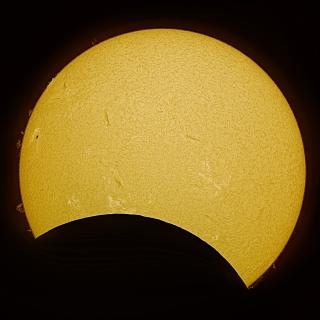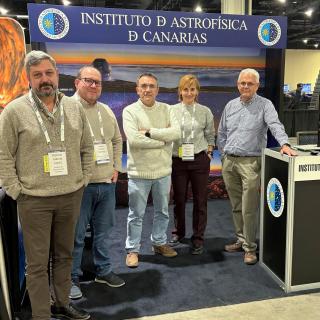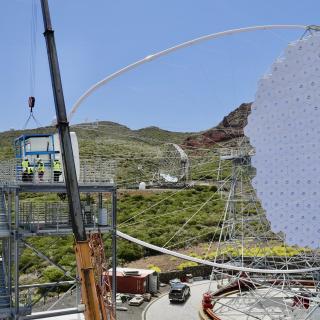It may interest you
-
 This Saturday, 29 March 2025, the Instituto de Astrofísica de Canarias (IAC) was able to follow the partial solar eclipse from the Teide Observatory in Tenerife. Although subtle to the naked eye, this eclipse was used by the IAC's outreach team to raise awareness of the phenomenon among a group of people from the ‘Friends of the IAC’ programme and IAC staff. At the same time, an observation was also made from the IAC Headquarters in La Laguna, which could be seen live on the centre's YouTube channel. The eclipse began at 09:14 UT and ended at 10:56 UT, with its maximum at 10:03 UT. For justAdvertised on
This Saturday, 29 March 2025, the Instituto de Astrofísica de Canarias (IAC) was able to follow the partial solar eclipse from the Teide Observatory in Tenerife. Although subtle to the naked eye, this eclipse was used by the IAC's outreach team to raise awareness of the phenomenon among a group of people from the ‘Friends of the IAC’ programme and IAC staff. At the same time, an observation was also made from the IAC Headquarters in La Laguna, which could be seen live on the centre's YouTube channel. The eclipse began at 09:14 UT and ended at 10:56 UT, with its maximum at 10:03 UT. For justAdvertised on -
 The Instituto de Astrofísica de Canarias (IAC) is demonstrating the quality and international relevance of the Canary Islands Observatories at the 245th session of the American Astronomical Society (AAS) meeting being held this week in Maryland (USA). This meeting, led by the American astrophysics community, brings together the world's most important research centres in this field to share lines of work and proposals for the present and the future. The IAC delegation in Maryland is headed by the director of the centre, Valentín Martínez Pillet, who is part of the panel of speakers with aAdvertised on
The Instituto de Astrofísica de Canarias (IAC) is demonstrating the quality and international relevance of the Canary Islands Observatories at the 245th session of the American Astronomical Society (AAS) meeting being held this week in Maryland (USA). This meeting, led by the American astrophysics community, brings together the world's most important research centres in this field to share lines of work and proposals for the present and the future. The IAC delegation in Maryland is headed by the director of the centre, Valentín Martínez Pillet, who is part of the panel of speakers with aAdvertised on -
 The Roque de los Muchachos Observatory (ORM) of the Instituto de Astrofísica de Canarias (IAC), located on La Palma, has reached another important milestone with the installation of the camera of the LST-4, one of the four Large-Sized Telescopes (LST), which will be part of the Cherenkov Telescope Array Observatory (CTAO), currently under construction. The installation of the camera represents the completion of the telescope assembly and marks its transition to the commissioning phase. After a thorough performance evaluation at the IACTEC building, the IAC's technological and businessAdvertised on
The Roque de los Muchachos Observatory (ORM) of the Instituto de Astrofísica de Canarias (IAC), located on La Palma, has reached another important milestone with the installation of the camera of the LST-4, one of the four Large-Sized Telescopes (LST), which will be part of the Cherenkov Telescope Array Observatory (CTAO), currently under construction. The installation of the camera represents the completion of the telescope assembly and marks its transition to the commissioning phase. After a thorough performance evaluation at the IACTEC building, the IAC's technological and businessAdvertised on